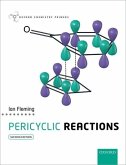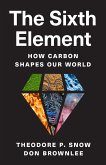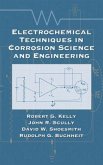22,99 €
inkl. MwSt.
Versandfertig in 2-4 Wochen

11 °P sammeln
- Broschiertes Buch
- Merkliste
- Auf die Merkliste
- Bewerten Bewerten
- Teilen
- Produkt teilen
- Produkterinnerung
- Produkterinnerung
Through an innovative combination of image and text, Peter Atkins explains the processes involved in chemical reactions. He introduces the 'tool kit' of basic reactions, such as precipitation, corrosion, and catalysis, and shows how these building blocks are brought together in more complex processes such as photosynthesis.
Andere Kunden interessierten sich auch für
![Radical Reactions in Organic Synthesis Radical Reactions in Organic Synthesis]() Samir Z. Zard (Ecole Polytechniq Departement de Synthese OrganiqueRadical Reactions in Organic Synthesis136,99 €
Samir Z. Zard (Ecole Polytechniq Departement de Synthese OrganiqueRadical Reactions in Organic Synthesis136,99 €![Pericyclic Reactions Pericyclic Reactions]() Ian Fleming (Emeritus Professor, Emeritus Professor, Department ofPericyclic Reactions52,99 €
Ian Fleming (Emeritus Professor, Emeritus Professor, Department ofPericyclic Reactions52,99 €![The Sixth Element The Sixth Element]() Theodore P. SnowThe Sixth Element24,99 €
Theodore P. SnowThe Sixth Element24,99 €![Why Chemical Reactions Happen Why Chemical Reactions Happen]() James KeelerWhy Chemical Reactions Happen58,99 €
James KeelerWhy Chemical Reactions Happen58,99 €![Electrochemical Techniques in Corrosion Science and Engineering Electrochemical Techniques in Corrosion Science and Engineering]() Robert G. Kelly (University of Virginia, Charlottesville, USA)Electrochemical Techniques in Corrosion Science and Engineering357,99 €
Robert G. Kelly (University of Virginia, Charlottesville, USA)Electrochemical Techniques in Corrosion Science and Engineering357,99 €![Introduction to Nuclear Reactions Introduction to Nuclear Reactions]() Carlos BertulaniIntroduction to Nuclear Reactions51,99 €
Carlos BertulaniIntroduction to Nuclear Reactions51,99 €![Unimolecular Reactions Unimolecular Reactions]() Wendell Forst (Universite de Bordeaux)Unimolecular Reactions122,99 €
Wendell Forst (Universite de Bordeaux)Unimolecular Reactions122,99 €-
-
-
Through an innovative combination of image and text, Peter Atkins explains the processes involved in chemical reactions. He introduces the 'tool kit' of basic reactions, such as precipitation, corrosion, and catalysis, and shows how these building blocks are brought together in more complex processes such as photosynthesis.
Produktdetails
- Produktdetails
- Verlag: Oxford University Press
- Seitenzahl: 200
- Erscheinungstermin: 28. Februar 2013
- Englisch
- Abmessung: 216mm x 141mm x 15mm
- Gewicht: 282g
- ISBN-13: 9780199668809
- ISBN-10: 0199668809
- Artikelnr.: 36684314
- Herstellerkennzeichnung
- Libri GmbH
- Europaallee 1
- 36244 Bad Hersfeld
- gpsr@libri.de
- Verlag: Oxford University Press
- Seitenzahl: 200
- Erscheinungstermin: 28. Februar 2013
- Englisch
- Abmessung: 216mm x 141mm x 15mm
- Gewicht: 282g
- ISBN-13: 9780199668809
- ISBN-10: 0199668809
- Artikelnr.: 36684314
- Herstellerkennzeichnung
- Libri GmbH
- Europaallee 1
- 36244 Bad Hersfeld
- gpsr@libri.de
Peter Atkins is the author of about 70 books, including the world-renowned and widely used Physical Chemistry, now in its 10th edition. He won the Grady-Stack award for science journalism in 2016. After graduating from the University of Leicester and a post-doctoral year in the University of California, Los Angeles, he returned to Oxford in 1965 as Fellow of Lincoln College and University Lecturer (later Professor) in physical chemistry. He retired in 2007, but continues to write and lecture worldwide.
Preface
A preliminary comment: water
The basic tools
1: Matter falling out (Precipitation)
2: Protons in transit (Neutralization)
3: Buring in air (Combustion)
4: Back to basics (Reduction)
5: Electrons in transit (Redox)
6: Forcing change electrically (Electrolysis)
7: Electricity from chemistry (Electrochemistry)
8: The death of metal (Corrosion)
9: Civil partnerships (Lewis acid-base reactions)
10: Changing partners (Complex substitution)
11: Marriage broking (Catalysis)
12: Divorce and reconciliation (Radical recombination)
Assembling the workshop
13: Stringing along (Radical polymerization)
14: Snapping together (Condensation polymerization)
15: Sniffing out nuclei (Nucleophilic substitution)
16: Sniffing out electrons (Electrophilic substitution)
17: Proton accelerators (Acid catalysis)
18: Basic instincts (Base catalysis)
19: adding up (Addition)
20: Taking away (Elimination)
21: Carbon footprints (The Wittig reaction)
22: Networking opportunities (The Friedel-Crafts reaction)
23: Dark matter (Photocromism)
24: Irritating atmospheres (Photochemical smog)
25: Seeing the light (Vision)
26: Green chemistry
Building for design
27: Food for thought (Enzyme control)
28: Grand designs (Synthesis)
A retrospective: bringing it all together
Glossary
Index
A preliminary comment: water
The basic tools
1: Matter falling out (Precipitation)
2: Protons in transit (Neutralization)
3: Buring in air (Combustion)
4: Back to basics (Reduction)
5: Electrons in transit (Redox)
6: Forcing change electrically (Electrolysis)
7: Electricity from chemistry (Electrochemistry)
8: The death of metal (Corrosion)
9: Civil partnerships (Lewis acid-base reactions)
10: Changing partners (Complex substitution)
11: Marriage broking (Catalysis)
12: Divorce and reconciliation (Radical recombination)
Assembling the workshop
13: Stringing along (Radical polymerization)
14: Snapping together (Condensation polymerization)
15: Sniffing out nuclei (Nucleophilic substitution)
16: Sniffing out electrons (Electrophilic substitution)
17: Proton accelerators (Acid catalysis)
18: Basic instincts (Base catalysis)
19: adding up (Addition)
20: Taking away (Elimination)
21: Carbon footprints (The Wittig reaction)
22: Networking opportunities (The Friedel-Crafts reaction)
23: Dark matter (Photocromism)
24: Irritating atmospheres (Photochemical smog)
25: Seeing the light (Vision)
26: Green chemistry
Building for design
27: Food for thought (Enzyme control)
28: Grand designs (Synthesis)
A retrospective: bringing it all together
Glossary
Index
Preface
A preliminary comment: water
The basic tools
1: Matter falling out (Precipitation)
2: Protons in transit (Neutralization)
3: Buring in air (Combustion)
4: Back to basics (Reduction)
5: Electrons in transit (Redox)
6: Forcing change electrically (Electrolysis)
7: Electricity from chemistry (Electrochemistry)
8: The death of metal (Corrosion)
9: Civil partnerships (Lewis acid-base reactions)
10: Changing partners (Complex substitution)
11: Marriage broking (Catalysis)
12: Divorce and reconciliation (Radical recombination)
Assembling the workshop
13: Stringing along (Radical polymerization)
14: Snapping together (Condensation polymerization)
15: Sniffing out nuclei (Nucleophilic substitution)
16: Sniffing out electrons (Electrophilic substitution)
17: Proton accelerators (Acid catalysis)
18: Basic instincts (Base catalysis)
19: adding up (Addition)
20: Taking away (Elimination)
21: Carbon footprints (The Wittig reaction)
22: Networking opportunities (The Friedel-Crafts reaction)
23: Dark matter (Photocromism)
24: Irritating atmospheres (Photochemical smog)
25: Seeing the light (Vision)
26: Green chemistry
Building for design
27: Food for thought (Enzyme control)
28: Grand designs (Synthesis)
A retrospective: bringing it all together
Glossary
Index
A preliminary comment: water
The basic tools
1: Matter falling out (Precipitation)
2: Protons in transit (Neutralization)
3: Buring in air (Combustion)
4: Back to basics (Reduction)
5: Electrons in transit (Redox)
6: Forcing change electrically (Electrolysis)
7: Electricity from chemistry (Electrochemistry)
8: The death of metal (Corrosion)
9: Civil partnerships (Lewis acid-base reactions)
10: Changing partners (Complex substitution)
11: Marriage broking (Catalysis)
12: Divorce and reconciliation (Radical recombination)
Assembling the workshop
13: Stringing along (Radical polymerization)
14: Snapping together (Condensation polymerization)
15: Sniffing out nuclei (Nucleophilic substitution)
16: Sniffing out electrons (Electrophilic substitution)
17: Proton accelerators (Acid catalysis)
18: Basic instincts (Base catalysis)
19: adding up (Addition)
20: Taking away (Elimination)
21: Carbon footprints (The Wittig reaction)
22: Networking opportunities (The Friedel-Crafts reaction)
23: Dark matter (Photocromism)
24: Irritating atmospheres (Photochemical smog)
25: Seeing the light (Vision)
26: Green chemistry
Building for design
27: Food for thought (Enzyme control)
28: Grand designs (Synthesis)
A retrospective: bringing it all together
Glossary
Index







